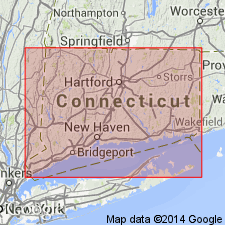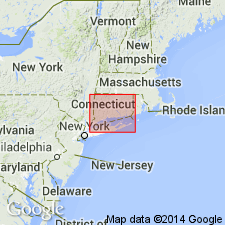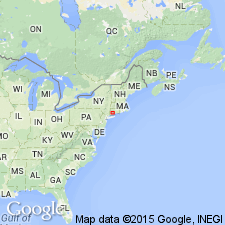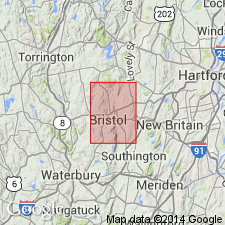
- Usage in publication:
-
- Bristol granite gneiss
- Modifications:
-
- Original reference
- Dominant lithology:
-
- Granite
- Gneiss
- Schist
- AAPG geologic province:
-
- New England province
Summary:
Pg. 104-105 and map. Bristol granite gneiss. Consists of granite of varying texture and color, of gneisses and schists derived from the granite, and of hornblende gneiss and hornblende schist. The typical granite gneiss is light gray, with gneissoid structure more or less developed by presence of layers of biotite; the more schistose layers have muscovite. Quartz, orthoclase, some oligoclase, andesine, and biotite are chief components. Garnet nearly always present and in places is principal mineral. Noticeable feature is presence of rounded and lens-shaped eyes, made up of zone of white, granular quartz-feldspar aggregate. Inside which is a dark spot composed largely of garnet and chlorite. Covers large part of Bristol Township, central Connecticut. Age is Ordovician(?).
Source: US geologic names lexicon (USGS Bull. 896, p. 267).

- Usage in publication:
-
- Bristol granite-gneiss
- Modifications:
-
- Overview
- AAPG geologic province:
-
- New England province
Summary:
Pg. 34. Bristol granite-gneiss was originally a mass of granite and diorite intruded into Hartland [Hoosac] schist. Age is Ordovician(?).
Source: US geologic names lexicon (USGS Bull. 896, p. 267).

- Usage in publication:
-
- Bristol quartz diorite
- Modifications:
-
- Overview
- AAPG geologic province:
-
- New England province
Summary:
Bristol quartz diorite appears to be older than Brookfield diorite.
Source: US geologic names lexicon (USGS Bull. 896, p. 267).

- Usage in publication:
-
- Bristol Gneiss*
- Modifications:
-
- Revised
- Dominant lithology:
-
- Gneiss
- AAPG geologic province:
-
- New England province
Summary:
Bristol Member of Collinsville Formation (Stanley, 1964) is here raised in rank and revised as Bristol Gneiss in the report area. Garnet- and epidote-bearing amphibolite and hornblende gneiss assigned by Stanley to the upper part of his Bristol Member is here assigned to base of the overlying Collinsville Formation and composes the unnamed hornblende gneiss member. As defined here, the Bristol Gneiss consists of plagioclase-quartz gneiss characterized by foliae of muscovite or biotite, or locally chlorite, which in places give the unit a striking pinstriping; contains scattered small garnets and large pods of amphibolite. Average thickness may be about 2,000 ft; thickness varies due to local intense folding. Probably correlates with the Moretown Formation of central MA, in which case it would constitute a fourth member of Stanley's Taine Mountain Formation. Formational status assigned in this report based on its unique textural and lithological character. Inferred age is Middle Ordovician.
Source: GNU records (USGS DDS-6; Reston GNULEX).
For more information, please contact Nancy Stamm, Geologic Names Committee Secretary.
Asterisk (*) indicates published by U.S. Geological Survey authors.
"No current usage" (†) implies that a name has been abandoned or has fallen into disuse. Former usage and, if known, replacement name given in parentheses ( ).
Slash (/) indicates name conflicts with nomenclatural guidelines (CSN, 1933; ACSN, 1961, 1970; NACSN, 1983, 2005, 2021). May be explained within brackets ([ ]).

